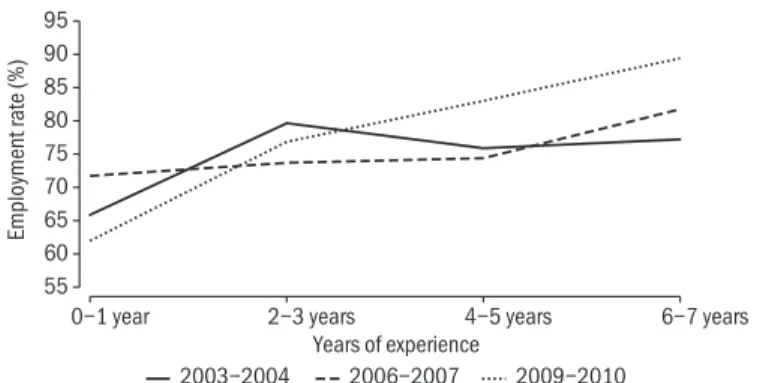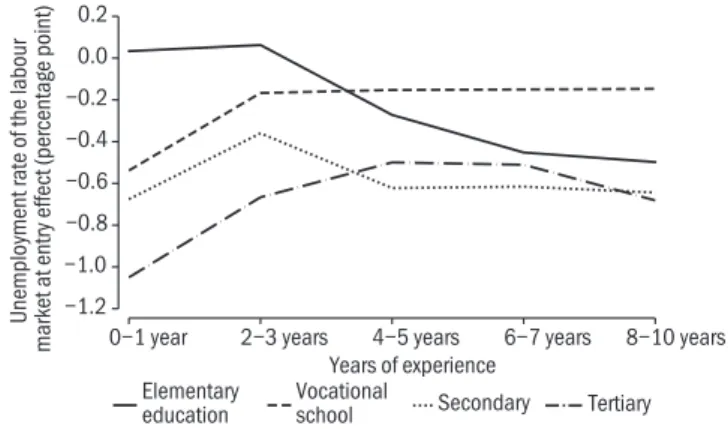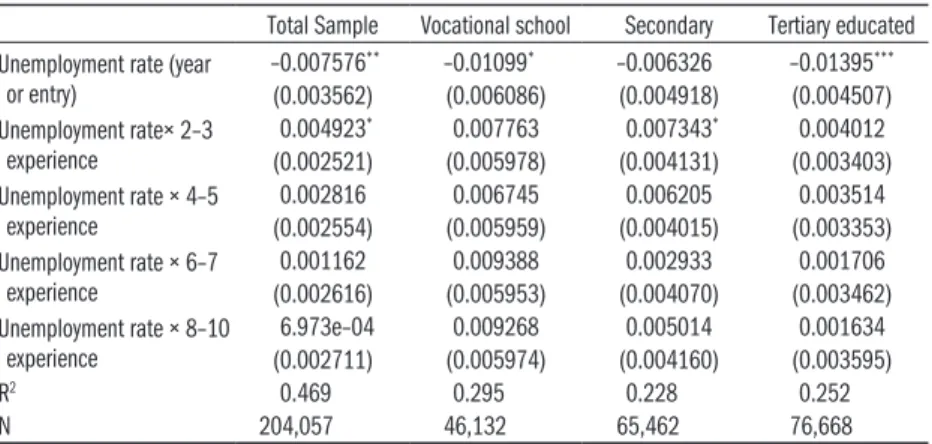4.1 Does the economic recession have permanent effects?
89
4 EARLY UNEMPLOYMENT AND LATER LABOUR MARKET OUTCOMES
4.1 DOES THE ECONOMIC RECESSION HAVE PERMANENT EFFECTS?
Márton Csillag
What happens if a young person enters a particularly bad labour market after completing their studies? Can we trust that, once an economic recession has passed, these young people will benefit as much of the fruits of the economic recovery as their older counterparts? Or will they be in a permanently weaker position due to the erosion of their human capital – as they are out of work or in “bad jobs,” or in positions that do not match their knowledge? This is the issue we are exploring here based on Hungarian data.
Throughout our analysis, we examined the trajectory of school graduation cohorts.1 We included young men who entered the labour market between 2001 and 2015, and since we used data from 2002–2017, we followed their lives for up to 15 years. Our basic question is the following: if someone gradu- ated in a year and/or county which has a high unemployment rate,2 then how much more likely is it that they will be non-employed or have lower wages, than a similar young person, who graduated in a better year (or in a county with more favourable labour market conditions), even years after a negative labour market shock? We used the data of the 2002–2017 CSO Labour Force Survey for our analysis. Our sample included those men born between 1970 and 1999 who completed their studies between 2001 and 2015.3 Although we know in which year the responder graduated, but we do not know where they lived at the time, therefore we assume that this corresponds with their current residence.4
On Figure 4.1.1 we present the probability of the members of the cohorts5 who finished their studies in different years – to be employed6 – depending on labour market experience. Based on the figure it is clear that even though in the years of the recession the employment rate of young entrants was quite low, the current conditions of the labour market more strongly influence the labour market status than the unemployment rate characterizing market entry.
Therefore, for instance the employment of the cohort finishing in 2003–2004 dropped significantly around 2008–2010 (after 4–7 years of work experience).
We present the results of our first, basic regression analysis on Figure 4.1.2.
We used simple linear regression, where the key independent variable was the county unemployment rate in the year of graduating, as well as its interaction with (potential) labour market experience.7 The figure illustrates, that if the young person left school in a year (or country) in which the unemployment
1 Although follow-up data ex- ist at an individual level in the Admin3 database of the CERS Databank, however education level in that dataset can only be determined after 2009, and thus the time series available would have been too short.
2 Here, we used the registered unemployment rate of the Na- tional Employment Service in annual and county breakdown.
3 We did not include those in the analysis who did not finish primary school.
4 This has the consequence that if young people move to places with better labour market con- ditions after graduation, the estimate of the effect of un- employment on entry will be biased towards 0.
5 The average unemployment rate varied in three groups: 9.5 percent in 2002–2003, 10.6 percent in 2005–2006, 14.6 percent in 2009–2010.
6 In the following, we do not consider those in public works jobs to be employed, as we fo- cus on primary labour market employment. Naturally, full- time students are not included in the sample either.
7 In addition, potential labour market experience, educational attainment, and micro-region of residence, as well as the calendar year and the month of the survey conducted were included as control variables.
55 60 65 70 75 80 85 90 95
Employment rate (%)
0−1 year 2−3 years 4−5 years 6−7 years
Years of experience
2003−2004 2006−2007 2009−2010
−1.5
−1.0
−0.5 0.0 0.5 1.0 1.5
Unemployment rate of the labour market at entry effect (percentage point)
0−1 year 2−3 years 4−5 years 6−7 years 8−10 years Employed Years of experienceNEET Unenmployed
Márton Csillag
90
rate was 1 percentage point higher,8 then how much do the labour outcomes of the youth change throughout the years spent on the labour market. Our results show that the unfavourable labour market situation quite significantly decreases the employment probability of new entrants, and although this unfa- vourable effect later subsides, it does not disappear. This means that if a young person entered the labour market during the recent recession, when unemploy- ment was around 5 percentage points higher (than in previous years), then the probability of them being employment 6–7 years later was 4 percentage points lower. Similarly, the labour market shock increased the risk of unem- ployment as well9 by roughly 3 percentage points even 8–10 years afterwards.
Figure 4.1.1: Youth employment in terms of labour market experience, in three graduation cohorts (between 2003–2017)
Source: Own calculation based on the CSO Labour Force Survey data 2003–2017.
Figure 4.1.2: The effects of the unemployment rate in the year of graduation on youth labour market status in terms of labour market experience, 2002–2017
(percentage points)
Source: Own calculation based on the CSO Labour Force Survey data 2003–2017.
As the labour market is segmented by education level (amongst other things), we also examined the extent to which the lasting negative effects of the labour
8 It should be noted, that there is significant variance in our key variable (the county unemployment rate) both in terms of time and territory.
That is, during the years of the crisis (between 2009–2012), the unemployment rate was on average 5.5 percent higher than in 2002. At the same time, the rate in Borsod-Abaúj-Zemplén or Jász-Nagykun-Szolnok countries was on average 16 percentage points higher than in Budapest.
9 We only included those active in the labour market.
−1.2
−1.0
−0.8
−0.6
−0.4
−0.2 0.0 0.2
0−1 year 2−3 years 4−5 years 6−7 years 8−10 years Elementary
education Vocational
school Secondary Tertiary Years of experience
Unemployment rate of the labour market at entry effect (percentage point)
4.1 Does the economic recession have permanent effects?
91 market shock varies amongst young people with different levels of education.
According to Figure 4.2.3, the so-called scarring effect which impacts sub- sequent employment, or even the whole career, appears mainly in the case of those with secondary or higher education, whilst the negative effects are less significant in the case of those with lower educational attainment.10
Figure 4.1.3: The effects of the unemployment rate in the year graduation on youth employment, by educational attainment groups, 2002–2017 (percentage points)
Source: Own calculation based on the CSO Labour Force Survey data 2003–2017.
Next, we examined another measure of labour market success, earnings, and we tried to draw conclusions regarding position and the quality of the com- pany.11 Our results demonstrate that in general, the lasting effects of a poor labour market start are negligible, as seen in the first column of Table 4.1.1.
At the same time, those with higher education were paid around 5 percentage points less even 4–6 years after the recession, than those entering a favour- able labour market (assuming that they entered the market in a year with a 5 percentage point higher unemployment rate).12 Surprisingly, this is not due to lower position or that the young person “got stuck” at a low-wage compa- ny.13 We also tried to find out whether those entering the labour market dur- ing the recession are “overqualified”, i.e. if they are in an occupation which is characterized by lower education-levels than theirs. Similar to the above results, we did not find any indication that those youth leaving education in the years of the recession would get stuck at a low quality jobs.
Our results suggest that the scarring effects of entering the labour market in a recession in Hungary appeared mainly in permanently lower employ- ment. Wage disadvantages emerged only for those with tertiary education.14 It should also be noted that it is possible that the negatives effects on those with higher education could have been greater if the cohorts entering the la- bour market during the recession would not have been significantly smaller than the generations in the early 2000s.15 Our results echo other European analyses which found the effects on wages to be smaller, but they showed that
10 In the case of unemployment probability, there is no such dif- ference for those with different educational qualifications, only the negative effect on those with vocational education is exceptionally high.
11 We did this with the help of the 2001–2016 Wage Tariff Survey of NES. Sample selec- tion was done similar to the above analysis. Our depend- ent variable was the logarithm of gross monthly real earnings (including 1/12 of non-regular income). The basic equation in- cluded educational attainment (7 categories), categories of ex- perience, the country, the cal- endar year. In addition to the basic equation, we first includ- ed the occupation (three-digit FEOR code), and then indicator variables for the identity of the company.
12 At the same time, it is pos- sible that because employment declined, selection intensified and therefore we can only give a lower estimate of the wage effect.
13 That is, in the models in which we included occupation and corporate fixed effects, the results did not change.
14 That is, it is possible that the short-term effects of the negative labour market shock will not become permanent for those with lower education, as in their case there is no serious depreciation of human capital.
15 These preliminary results further justify a closer exami- nation of the careers of young people with higher education (see Chapter 8 of In Focus).
Márton Csillag
92
employment permanently decreases as a result of a poor labour market entry situation. (See Box 4.1 for more information.)
Table 4.1.1: The effects of early-stage unemployment on wages
Total Sample Vocational school Secondary Tertiary educated Unemployment rate (year
or entry)
–0.007576** –0.01099* –0.006326 –0.01395***
(0.003562) (0.006086) (0.004918) (0.004507) Unemployment rate× 2–3
experience
0.004923* 0.007763 0.007343* 0.004012 (0.002521) (0.005978) (0.004131) (0.003403) Unemployment rate × 4–5
experience
0.002816 0.006745 0.006205 0.003514
(0.002554) (0.005959) (0.004015) (0.003353) Unemployment rate × 6–7
experience
0.001162 0.009388 0.002933 0.001706
(0.002616) (0.005953) (0.004070) (0.003462) Unemployment rate × 8–10
experience
6.973e–04 0.009268 0.005014 0.001634
(0.002711) (0.005974) (0.004160) (0.003595)
R2 0.469 0.295 0.228 0.252
N 204,057 46,132 65,462 76,668
Note: The basic equation included educational attainment (7 categories), categories of experience, the country, the calendar year. Clustered (at the level of the firm) standard errors are displayed in brackets.
Significant at the ***1 percent level, **5 percent level, *10 percent level.
Source: Own calculation based on the NES Wage Survey data 2002–2016.
K4.1 What are the consequences of young people entering the labour market during an economic crisis? International outlook
Endre Tóth The scarring effect refers to those negative conse-
quences which affect young people who begin their careers with a potential period of unemployment.
In labour economics, two different issues are exam- ined under this term. First: whether young people who leave school during a recession and start their career therefore face higher risks of early-stage un- employment are permanently “scarred” by these circumstances. Second: for those young people who experience lasting unemployment when start- ing their career, does this episode have long-term negative effects on their later career? This topic re- emerged in the literature due to the severe econom-
ic and financial recession in 2008, and in order to eliminate these negative consequences, the Euro- pean Union introduced their Youth Guarantee Pro- gramme in 2013.1
The majority of research on the scarring effect examines this phenomenon via regression model building, analysing young people belonging to dif- ferent cohorts, where the key independent varia- ble is the labour market situation of the youth’s place of residence at the time of leaving school. In 1 For the implementation of this Hungary, see
Subchapter 5.2.


